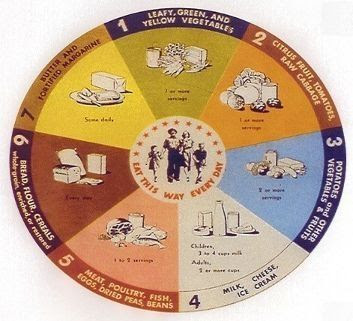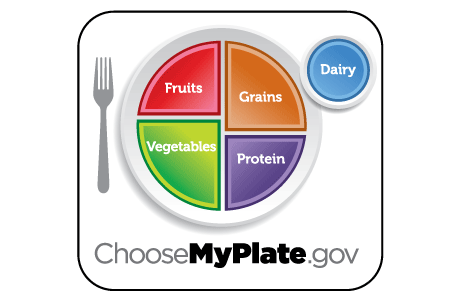This has been bugging me for a while, so I thought I would finally throw my hat in the ring regarding the food pyramid evolution in the US. When the thing was first thought up, it wasn't anything like what we know now. Malnutrition from lack of eating
enough. This is why the USDA was even created in the first place, let alone the food guides.

Back in the 1860s, all it took to make a healthier population was to encourage people to eat more. Food was mostly whole foods and eating more meant eating better. Knowing a bit about the time period, regular meals consisting of only bread weren't uncommon. The first true guide came out in 1916 and created the idea of food groups. I could go into details about the various evolutions thereafter, but honestly this little chart here offers anything I might say in this short post.
The problem I have has several facets. Firstly is that the shift in our food's nature
led to a version of the food pyramid that I considered one of the best we ever offered. It was still influenced by the food lobbyists (more on that in a moment), but it offered a broader view of our diets. Even better, it had a very detailed website where you could chart out the sorts of activity you did daily from a list of what I believe was several hundred to a few thousand options (the site is gone so I can't go check the numbers any more) to see what sorts of things your body was going to be using more of. Data about your weight, bmi, gender, age, health history, etc all got fed into the system and then it would adjust the pyramid based on your unique needs.
Even better, it was more active in helping you find the right sorts of foods than any pyramid before or since. It would break down veggies into different sorts such as dark leafy greens for example. It wasn't just eat a number of veggies, it was “These are the sorts of veggies that will have the vitamins and minerals you most need”. It did what the Eat Right Guide (never released in the original form due to lobbying) was supposed to do somewhat better than the hybridized version that was to become our 'food pyramid'.
It wasn't perfect. They got rid of the stupid 'starches' category and changed to grains, implying whole grains by the term and then going so far as to actively say at least half
should be whole grains. They still listed
milk, but then clarified it should be 'calcium rich foods' which extends beyond just milk. The lobbyists wouldn't let them remove milk, make notations to avoid processed foods, or shift the ratio in favor of extra vegetables and less meat/dairy aspects in avoidance of fats... but they did find some creative ways to imply it anyway.
Anyway, I could go on and on about the ways things got tweeked and skewed over the years, but my point is this: I hate the new food plate. Every stride made by the MyPyramid version was lost as the whole thing got dumbed back down again. They offer a few vague calorie counts based on age, a handful of exercise activities and some minor suggestions. At least they kept the word grains instead of slipping back into starches (sometimes listed bread and grains).
I really wish the MyPyramid site was still around. I'd love to see someone create a clean food chart that isn't bullied into shape by lobbies. One where it was based on nutrition, not broad strokes of ideas. Veggies alone deserve ten different categories. Proteins, not 'Meat and beans”. Calcium Rich Foods, not Milk. Possibly with a chart of the many factors that can influence needing more or less of this or that.
I love milk and meat, but I also recognize that they aren't the only way to get the nutrition that they provide. Vegans and Vegetarians clearly demonstrate that it is possible (if not always easy) to get a balanced diet without them. Maybe we could call it the Permies Food Pyramid? Heh. Something to think about. Sorry if I ranted a little there. I almost put this into a section of the forum more suited to flipping tables over, but decided this is best suited to a discussion of food choices.
You are free to call me out if I misquoted a date. You are more than welcome to disagree with me. I am entirely happy to have an open discussion of our differing or matching opinions. I am largely curious to know if anyone else even realized the MyPyramid site did all that. The only reason I knew was because I had been working in a hospital's food service department at the time. I was really disappointed when it went away and the new MyPlate came in. It is so much less useful as a website for improving your healthy eating. So, thoughts, opinions?






 4
4















 1
1






















 1
1




 1
1












 2
2









